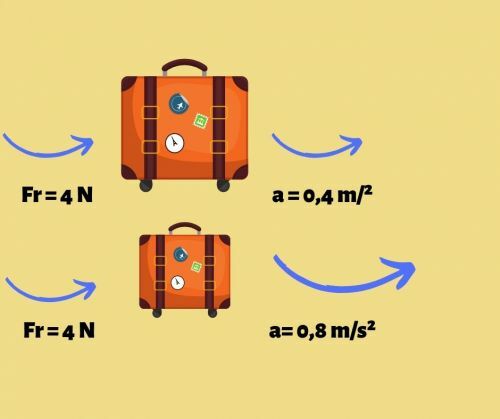Newton's second law, also known as fundamental principle of dynamics, deals with the relationship between the force and acceleration of a body.
This is the second of the three laws of Isaac Newton, that explain the dynamics of the movement of bodies. Newton's 1st, 2nd and 3rd Laws were published in 1687, in the book entitled Mathematical Principles of Natural Philosophy.
This is the only Newton's law that can be represented by an equation, where the net force (Fr) is equal to the product of mass (m) and acceleration (a).

Explanation of Newton's 2nd Law
According to this law, for a body to gain acceleration and change its velocity, a force must be applied to it. The second law, therefore, deals with cases where there are acceleration in the movement of bodies, differing from the first law, which deals with cases in which acceleration is null.
Learn more about Newton's first law and Newton's third law.
For a body to come out of its equilibrium state and gain acceleration, the net force applied to it must be nonzero.
This means that, if there is more than one force exerted on the body, it is necessary to add all the forces, because these forces can intensify if they have the same direction and direction, or they can cancel each other out, if they have opposite directions, by example.
See the equation of this law:

From this relationship we observe that the resulting force can be calculated by multiplying the mass of the body by the acceleration. Through the formula, we also found that force and mass are directly proportional quantities.
This means that the greater the mass, the greater the strength of the force for the body to gain acceleration. This happens due to inertia of the body, which is its tendency to remain in its balanced state.
Mass is the quantitative measure of inertia, so the greater the mass, the greater the inertia of a body. See this example:
- On a flat surface are two wooden boxes, one weighing 5 kg, the other 500 kg. If a person tries to push these boxes, he will find it much easier to move the lighter box, as its mass is smaller and therefore its inertia is also smaller.
On the other hand, we can observe that the mass and acceleration are inversely proportional quantities. This is because, the greater the mass of a body, the greater its resistance to changing speed and, therefore, the lesser its acceleration.
To clarify this relationship, see this example:
Consider two bodies with different masses, body A has a mass of 10 kg and body B has a mass of 5 kg and a force of the same intensity is applied to both bodies.
 By applying the same force, the less massive body gained more acceleration.
By applying the same force, the less massive body gained more acceleration.
In this case, body B will gain a greater acceleration than body A. This is because body B's mass is smaller and therefore its resistance to speeding is less.
The measurement units of these quantities are:
- Force (F) - Newton
- Mass (m) - kg
- Acceleration (a) - m/s²
See also the meaning of inertia and strength.
Now that you understand what Newton's second law is, look at the example of a exercise practical.
- Considering two bodies A and B, both weighing 100 kg. A force of 40 newtons is applied to body A and to body B a force of 60 newtons is applied. What is the acceleration acquired by each of the bodies?
Using the formula:

| Body A | Body B |
|
40 = 100.a a= 40/100 a=0.4 m/s² |
60 = 100.a a = 60/100 a = 0.6 m/s² |
As a result, we have to acceleration of body B is greater than acceleration of body A. As both have the same mass, the acceleration was greater in the case where the resulting force applied to the body was more intense.
Learn more about Newton's laws and dynamics.


